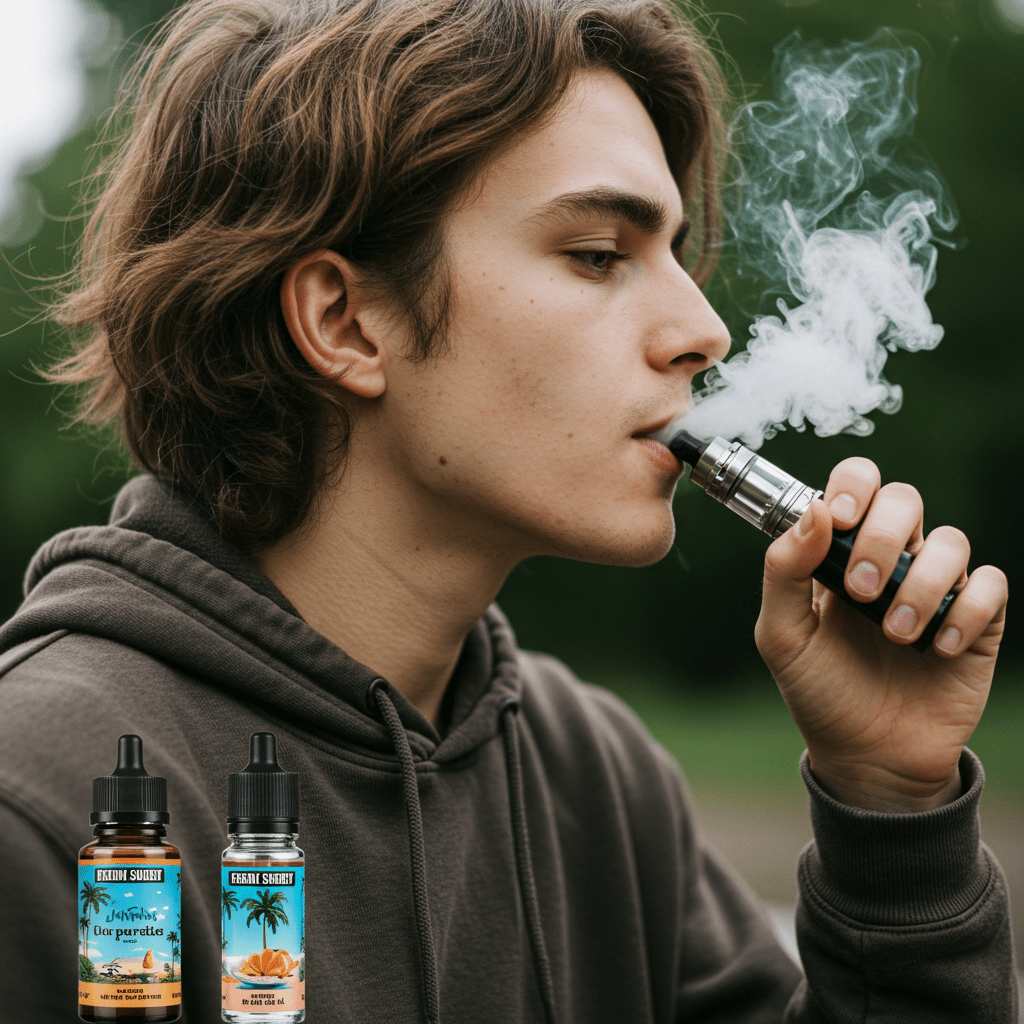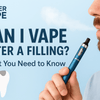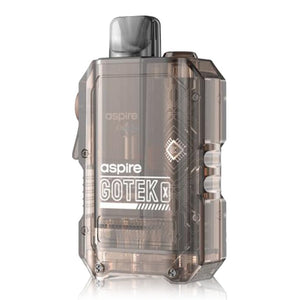How Much Nicotine is in a Vape? A Comprehensive Guide for UK Vapers

How Much Nicotine is in a Vape? A Comprehensive Guide for UK Vapers
Vaping has become a popular alternative to traditional smoking, but understanding the nicotine content of e-liquids can be confusing. This comprehensive guide aims to demystify the world of vape nicotine, providing clear and concise information for UK vapers. We'll cover everything from nicotine strengths and calculations to safety considerations, choosing the right level, exploring different devices, diving into health impacts, and much more.
Understanding Nicotine Strength in Vape Juice
Nicotine strength in vape juice is typically measured in two ways:
- Milligrams per millilitre (mg/mL): This indicates the amount of nicotine present in each millilitre of e-liquid. For example, a 10mg/mL e-liquid contains 10 milligrams of nicotine per millilitre. This is the most common way nicotine strength is displayed in the UK.
- Percentage (%): This represents the percentage of nicotine in the e-liquid. A 1% nicotine solution is equivalent to 10mg/mL. You might see this more commonly in other countries.
Common Nicotine Strengths in the UK
In the UK, you'll generally find e-liquids with nicotine strengths ranging from 0mg/mL (nicotine-free) up to the legal limit of 20mg/mL. Here's a breakdown of common strengths and what they might be suitable for:
- 0mg/mL: Contains no nicotine. Popular among vapers who have successfully quit smoking and enjoy the flavour and experience of vaping without the addictive substance.
- 3mg/mL: A very low nicotine strength. Often chosen by ex-smokers who were light smokers or are trying to reduce their nicotine intake gradually.
- 6mg/mL: A low nicotine strength. Suitable for those who were light to moderate smokers.
- 10mg/mL: A medium nicotine strength. A common starting point for smokers transitioning to vaping.
- 12mg/mL: Another medium strength. Offers a slightly stronger hit than 10mg/mL.
- 18mg/mL & 20mg/mL: High nicotine strengths. Designed for heavy smokers who need a higher nicotine level to satisfy their cravings. 20mg/mL is the legal maximum in the UK.
Calculating Nicotine Content: A Simple Guide
Understanding how to calculate the total nicotine content in your e-liquid is essential. Here's the formula:
- Total Nicotine (mg) = E-liquid Volume (mL) x Nicotine Strength (mg/mL)
Example:
A 10mL bottle of e-liquid with a nicotine strength of 10mg/mL contains:
10mL x 10mg/mL = 100mg of nicotine.
Nicotine Salts vs. Freebase Nicotine: What's the Difference?
You might encounter two terms: nicotine salts and freebase nicotine. Here's a simplified explanation:
- Freebase Nicotine: This is the traditional form of nicotine used in most e-liquids. It's known for its harsher throat hit, especially at higher concentrations.
- Nicotine Salts: These are formed by combining freebase nicotine with an acid. Nicotine salts offer a smoother throat hit, even at higher nicotine strengths, allowing vapers to consume higher concentrations more comfortably. They are also absorbed into the bloodstream more quickly, providing a faster nicotine hit.
Nicotine salts are often used in pod systems and mouth-to-lung (MTL) devices, while freebase nicotine is more common in sub-ohm devices.
Choosing the Right Nicotine Strength for You
Choosing the right nicotine strength depends on several factors, including your previous smoking habits, vaping style, and personal preferences.
- Heavy Smokers: If you were a heavy smoker, you might want to start with a higher nicotine strength (18mg/mL or 20mg/mL) to satisfy your cravings.
- Light Smokers: Light smokers may find that lower nicotine strengths (6mg/mL to 12mg/mL) are sufficient.
- Ex-Smokers: Many ex-smokers eventually reduce their nicotine intake gradually, ultimately aiming for 0mg/mL.
- Vaping Style: MTL vaping, which mimics the experience of smoking a cigarette, often uses lower nicotine strengths than direct-to-lung (DTL) vaping, which produces larger clouds of vapour.
Tips for Finding Your Ideal Nicotine Level:
- Start Low, Go Slow: If you're unsure, it's best to start with a lower nicotine strength and gradually increase it if needed.
- Listen to Your Body: Pay attention to how your body feels after vaping. If you experience withdrawal symptoms, you might need a higher nicotine strength. If you feel jittery or nauseous, you might need to lower your nicotine intake.
- Consider Your Vaping Style: As mentioned earlier, MTL vapers often prefer lower nicotine strengths than DTL vapers.
- Experiment: Don't be afraid to try different nicotine strengths until you find what works best for you.
Nicotine Overdose: What You Need to Know
While rare, nicotine overdose is possible. Symptoms of nicotine overdose can include:
- Nausea
- Vomiting
- Dizziness
- Headache
- Increased heart rate
- Tremors
- Seizures (in severe cases)
If you suspect you've experienced a nicotine overdose, seek medical attention immediately.
Nicotine Addiction and Withdrawal
Nicotine is a highly addictive substance. If you're trying to reduce your nicotine intake or quit vaping altogether, you may experience withdrawal symptoms, such as:
- Irritability
- Anxiety
- Difficulty concentrating
- Insomnia
- Cravings
There are resources available to help you manage nicotine withdrawal, including nicotine replacement therapy (NRT) and counselling. Speak to your GP or a healthcare professional for advice and support.
Regulations Surrounding Nicotine in the UK
The Tobacco and Related Products Regulations 2016 (TRPR) in the UK sets strict limits on the sale and advertising of e-cigarettes and e-liquids, including:
- Maximum Nicotine Strength: The maximum nicotine strength allowed in e-liquids sold in the UK is 20mg/mL.
- Maximum E-liquid Bottle Size: E-liquid bottles containing nicotine are limited to a maximum capacity of 10mL.
- Restrictions on Advertising: Advertising of e-cigarettes and e-liquids is heavily restricted.
Safety Considerations for Vaping and Nicotine
- Keep E-liquids Out of Reach of Children and Pets: Nicotine is highly toxic, especially to children and animals. Store your e-liquids in a safe place, out of reach and sight.
- Use Proper Equipment: Use high-quality vaping devices and e-liquids from reputable brands.
- Be Aware of Potential Health Risks: While vaping is generally considered less harmful than smoking, it's not risk-free. More research is needed to fully understand the long-term health effects of vaping.
- Consult with a Healthcare Professional: If you have any concerns about vaping or nicotine use, speak to your GP or a healthcare professional.
Vaping Devices: A Detailed Overview
The world of vaping devices is diverse, offering options for every vaper. Here's a breakdown of the main types:
- Pod Systems: Compact and portable, pod systems use pre-filled or refillable pods containing e-liquid. They are often favoured by beginners and those seeking a discreet vaping experience. Pod systems are frequently used with nicotine salts due to their smooth delivery.
- Mods (Box Mods): More powerful and customisable, mods allow vapers to adjust wattage, temperature, and other settings. They are typically used with sub-ohm tanks and are popular among experienced vapers who enjoy large vapour clouds.
- Vape Pens: Resembling traditional pens, these devices are simple and easy to use. They are a good entry point for new vapers.
- Disposable Vapes: These single-use devices come pre-filled with e-liquid and are discarded once empty. They are convenient but can be less environmentally friendly.
Within these categories, there's a wide variety of features and specifications. Coil type, airflow, battery capacity, and tank capacity are all important factors to consider when choosing a device.
The Health Effects of Vaping: A Deeper Dive
While generally considered less harmful than smoking, vaping is not without potential health risks. Research is ongoing, but here's what we currently know:
- Respiratory Health: Vaping can irritate the airways and may contribute to respiratory problems. Long-term effects are still being studied.
- Cardiovascular Health: Nicotine can increase heart rate and blood pressure, potentially increasing the risk of cardiovascular disease.
- Addiction: Nicotine is highly addictive, and vaping can lead to nicotine dependence.
- Popcorn Lung (Bronchiolitis Obliterans): While rare, some flavourings used in e-liquids have been linked to this serious lung condition. Diacetyl, a chemical previously found in some flavourings, is a known cause. Regulations have largely eliminated its presence in UK e-liquids.
- Heavy Metals: Some studies have found trace amounts of heavy metals in vape aerosol, though the levels are generally much lower than in cigarette smoke.
It's important to note that vaping is still relatively new, and long-term studies on its health effects are ongoing. The consensus among public health organisations in the UK is that vaping is significantly less harmful than smoking, but it's not risk-free. If you're concerned about your health, it's always best to consult with a healthcare professional.
Flavourings in E-liquids: A Complex Landscape
E-liquids come in a vast array of flavours, from classic tobacco and menthol to fruity, sweet, and even dessert-inspired options. While flavourings contribute to the enjoyment of vaping, they also raise some concerns:
- Chemical Composition: E-liquid flavourings are made up of various chemicals, and some of these may have the potential to cause harm when inhaled. Research is ongoing to identify potentially harmful flavouring ingredients.
- "Popcorn Lung" and Diacetyl: As mentioned previously, diacetyl, a chemical previously used in some flavourings, has been linked to bronchiolitis obliterans ("popcorn lung"). Regulations in the UK have largely eliminated diacetyl from e-liquids.
- Unknown Long-Term Effects: The long-term effects of inhaling flavouring chemicals are not fully understood. More research is needed to assess the potential risks.
The History and Evolution of Vaping
Vaping has a surprisingly long history, with early concepts dating back centuries. However, the modern e-cigarette as we know it emerged much more recently:
- Early Inventions: Early devices aimed at vaporizing substances date back to the 19th century.
- The First Modern E-cigarette: The first commercially successful e-cigarette was developed in China in the early 2000s.
- Evolution of Devices: Since then, vaping devices have evolved rapidly, from simple cig-a-likes to sophisticated mods and pod systems.
- Rise in Popularity: Vaping has grown in popularity as an alternative to smoking, particularly in the last decade.
The Role of Vaping in Tobacco Harm Reduction
Tobacco harm reduction (THR) is a public health strategy that aims to reduce the negative health impacts associated with tobacco use. Vaping is often considered a key component of THR:
- Less Harmful than Smoking: The Royal College of Physicians and other reputable organisations in the UK have stated that vaping is significantly less harmful than smoking. This is because e-cigarettes don't produce the harmful combustion products found in cigarette smoke.
- Switching from Smoking: Vaping can be a helpful tool for smokers who are trying to quit. It provides a similar experience to smoking, including nicotine delivery, which can help manage cravings.
- Controversy and Debate: The role of vaping in THR is not without controversy. Some argue that vaping may act as a gateway to smoking for young people, while others worry about the long-term health effects of vaping.
Economic and Social Impact of Vaping
The vaping industry has a significant economic and social impact:
- Economic Growth: The vaping industry has created jobs and generated revenue.
- Public Health Implications: The potential impact of vaping on public health is a subject of ongoing debate.
- Youth Vaping: The rise in youth vaping is a concern, and regulations are in place to restrict sales to minors.
- Social Perceptions: Social perceptions of vaping vary, with some viewing it as a positive alternative to smoking and others expressing concerns about its potential risks.
Comparison of Vaping Regulations in Different Countries
Vaping regulations vary significantly across the globe:
- UK Regulations: The UK has relatively strict regulations on vaping, including limits on nicotine strength, bottle size, and advertising.
- EU Regulations: The EU also has regulations on vaping, though they may differ from the UK's.
- Other Countries: Regulations in other countries range from highly restrictive to more permissive. Some countries have even banned vaping altogether.
Conclusion
Understanding the nicotine content of your vape juice is crucial for a safe and enjoyable vaping experience. This expanded guide has provided you with the comprehensive information you need to make informed choices about nicotine strength, from calculations and comparisons to safety considerations, UK regulations, different devices, health impacts, flavourings, the history of vaping, its role in tobacco harm reduction, and much more.
Remember to vape responsibly and consult with a healthcare professional if you have any concerns. By staying informed and making responsible choices, you can enjoy vaping while managing your nicotine intake effectively. The ongoing research and evolving regulations make it essential to stay up-to-date on the latest information regarding vaping and nicotine.
-
Posted in
nicotine






